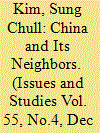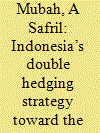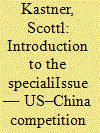| Srl | Item |
| 1 |
ID:
170627


|
|
|
|
|
| Summary/Abstract |
Since China’s economic rise, there has been an upsurge of cases demonstrating that the country has translated its increasing economic capabilities into political influence over other states. The focus of this paper is to investigate the case of China’s economic sanctions on South Korea in response to its Terminal High Altitude Area Defense (THAAD) deployment. Its goal is to deepen our understanding of how China has employed economic coercion in order to alter the policies of other states. China’s economic sanctions have included intentional ones like the Hallyu ban, a ban on tourism, non-tariff measures, the shutting down of Lotte Marts, and the fomenting of anti-Korean sentiment in its official media. There is however insufficient evidence to prove that these boycott movements and reductions in direct investment on the part of Chinese companies are government-mandated sanctions and not simply the choice of individual actors. Our findings indicate that due to its asymmetrical interdependence on China, South Korea was more vulnerable to economic sanctions and thus more likely to make political concessions.
|
|
|
|
|
|
|
|
|
|
|
|
|
|
|
|
| 2 |
ID:
170624


|
|
|
|
|
| Summary/Abstract |
With respect to China and its neighbors, what are the political implications when a great power advances economically into small states? This paper presents an asymmetry–coercion linkage to explain the relationship between a great power and small states by reconceptualizing Albert Hirschman’s theory of trade dependency. This reconceptualization involves two tasks. First, the paper explicates vulnerability to coercion as a consequence of economic asymmetry, whereby a small state becomes susceptible to a great power’s compellence or co-optation to take a certain path preferred by the latter. Second, in demonstrating and measuring vulnerability to coercion, the paper accounts for the three factors: trade concentration, non-transparency, and reliance on bilateral aid. The combined effect of these three factors is that among the six countries under investigation, Cambodia and North Korea are extremely vulnerable to China’s coercion, while Vietnam is the least vulnerable state
|
|
|
|
|
|
|
|
|
|
|
|
|
|
|
|
| 3 |
ID:
170628


|
|
|
|
|
| Summary/Abstract |
This study highlights Indonesia’s strategy in response to the growing competition between the United States and China. In recent years, Indonesia under the administration of President Joko Widodo has played a strategic role in maintaining regional stability in the Indo-Pacific amid inflaming tensions between the two countries. On the basis of an “independent and active” foreign policy with Association of Southeast Asian Nations (ASEAN) at the center of a concentric circle, Indonesia has employed a hedging strategy to bolster regional stability and foster cooperation among countries in the region. While there may be room for a hedging strategy, it is important to understand how Indonesia has employed this strategy to shape the regional order. This paper argues that Indonesia has adopted a double hedging strategy of economic pragmatism on the one hand and limited bandwagoning on the other. The former includes a deepening of economic cooperation with China through collaboration between Indonesia’s vision of a Global Maritime Fulcrum and China’s Belt and Road Initiative. The latter includes keeping the US involved in the Indo-Pacific by proposing its Indo-Pacific concept to regional players without challenging the existing proposals offered by major powers. This paper consists of four sections. The first section introduces the theoretical basis by focusing on Indonesia’s foreign policy ideas as it deals with competition between great powers. The second section discusses the synthesis of Indonesia’s vision of a Global Maritime Fulcrum and concept of the Indo-Pacific. The third section demonstrates how Indonesia has employed its double hedging strategy. The fourth section highlights the conclusions of this study by summarizing Indonesia’s response to competition between the US and China and providing recommendations for further research.
|
|
|
|
|
|
|
|
|
|
|
|
|
|
|
|
| 4 |
ID:
170625


|
|
|
| 5 |
ID:
170626


|
|
|
|
|
| Summary/Abstract |
This is a study of learning and socialization in China’s foreign security policy, examining how China has at times been more assertive and in other instances has taken a more accommodating approach in its foreign security policy behavior. This paper argues that China has been “socialized” by its international security environment by exploring Kenneth Waltz’s theoretical mechanism of the “socialization” of states in the international system. The 1995–1996 Taiwan Strait Crisis and the early 2000s, the Senkaku/Diaoyutai crises from 2012 to 2015, and the South China Sea in the mid-1990s are all instances in which China has employed force only to suffer strategically. This has eventually led to a less confrontational posture and contributed to the pursuit of a more cooperative engagement strategy with both Southeast Asia (from 1998 to 2008) and Taiwan (∼2006–2016). Variations in China’s assertiveness can be explained by the combination of domestic politics and signals from China’s international security environment.
|
|
|
|
|
|
|
|
|
|
|
|
|
|
|
|